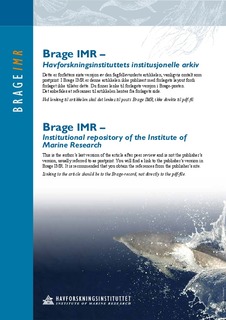Estimating tail-beat frequency using split-beam echosounders
Journal article, Peer reviewed
Permanent lenke
http://hdl.handle.net/11250/108533Utgivelsesdato
2009-02-04Metadata
Vis full innførselSamlinger
- Articles [3009]
Originalversjon
http://dx.doi.org/10.1093/icesjms/fsp003Sammendrag
Data from a standard split-beam echosounder are used to estimate tail-beat frequency within a dense herring (Clupea harengus L.) layer. The data were collected by lowering a horizontally projecting 38 kHz split-beam transducer into a herring layer at 245-m depth. Individual targets were concatenated into tracks, and a fast Fourier transform was used to estimate the periodogram of the backscattering strengths along each track. A simple model, assumed accurate under certain conditions, was used to relate the periodogram to tail-beat frequency. The requisite conditions are discussed. Examples of accurate tail-beat estimates from single high-quality tracks, which are consistent with statistics on all tracks in the test dataset, are presented. In addition, the cross periodogram between closely spaced individuals was calculated on selected tracks to estimate the relative phase between the adjacent tracks within the school. Finally, the potential use of this method to resolve schooling behaviour, improve target-strength estimates, and even estimate fish condition, is discussed.
Beskrivelse
This is a pre-copy-editing, author-produced PDF of an article accepted for publication in ICES Journal of Marine Science following peer review. The definitive publisher-authenticated version ICES J. Mar. Sci. (2009) 66 (6): 1252-1258 is available online at: http://icesjms.oxfordjournals.org/content/66/6/1252
